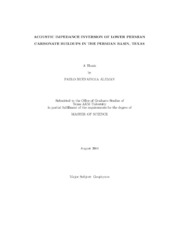Acoustic impedance inversion of the Lower Permian carbonate buildups in the Permian Basin, Texas
Abstract
Carbonate reservoirs are usually diffcult to map and identify in seismic sections due to their complex structure, lithology and diagenetic frabrics. The Midland Basin, located in the Permian Basin of West Texas, is an excellent example of these complex carbonate structures. In order to obtain a better characterization and imaging of the carbonate buildups, an acoustic impedance inversion is proposed here. The resolution of the acoustic impedance is the same as the input seismic data, which is greatly improved with the addition of the low frequency content extracted from well data. From the broadband volume, high resolution maps of acoustic impedance distributions were obtained, and therefore the locations of carbonate buildups were easily determined. A correlation between acoustic impedance and porosity extracted from well data shows that areas with high acoustic impedance were correlated with low porosity values, whereas high porosities were located in areas of low acoustic impedance. Theoretical analyses were performed using the time-average equation and the Gassmann equation. These theoretical models helped to understand how porosity distributions affect acoustic impedance. Both equations predicted a decrease in acoustic impedance as porosity increases. Inversion results showed that average porosity values are 5% [plus or minus] 5%, typical for densely cemented rocks. Previous studies done in the study area indicate that grains are moderately to well-sorted. This suggests that time-average approximation will overestimate porosity values and the Gassmann approach better predicts the measured data. A comparison between measured data and the Gassmann equation suggests that rocks with low porosities (less than 5%) tend to have high acoustic impedance values. On the other hand, rocks with higher porosities (5% to 10%) have lower acoustic impedance values. The inversion performed on well data also shows that the fluid bulk modulus for currently producing wells is lower than in non-productive wells, (wells with low production rates for brine and hydrocarbons), which is consistent with pore fluids containing a larger concentration of oil. The acoustic impedance inversion was demonstrated to be a robust technique for mapping complex structures and estimating porosities as well. However, it is not capable of differentiating different types of carbonate buildups and their origin.
Citation
Pablo, Buenafama Aleman (2004). Acoustic impedance inversion of the Lower Permian carbonate buildups in the Permian Basin, Texas. Master's thesis, Texas A&M University. Texas A&M University. Available electronically from https : / /hdl .handle .net /1969 .1 /1068.


